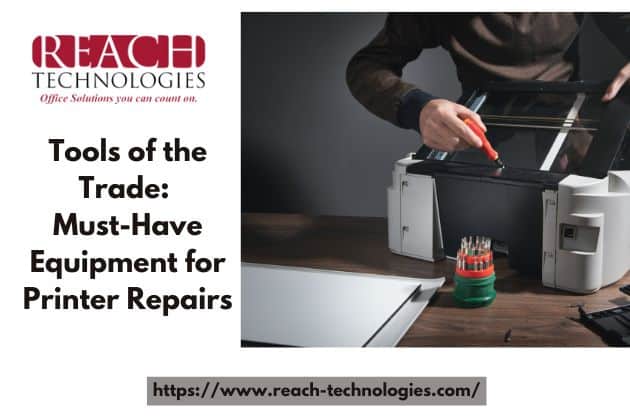
Printers are indispensable in both corporate and home office settings. However, like any machinery, they are prone to breakdowns. When a printer malfunctions, having the right tools at your disposal can mean the difference between a quick fix and a frustrating, time-consuming ordeal. Equipped with the proper gear, a technician can diagnose, repair, and maintain printers with precision and efficiency. This article delves into the essential tools every printer repair professional should have in their arsenal.
Diagnostic Tools: Identifying the Root Cause
Before any repair begins, pinpointing the exact issue is crucial. Diagnostic tools streamline this process and help eliminate guesswork.
- Multimeter for electrical testing – A digital multimeter is indispensable for checking voltage levels, continuity, and electrical faults in printer circuitry. It helps detect power supply failures and faulty wiring.
- Printer test sheets and calibration software – Print test pages highlight alignment issues, streaks, or color inconsistencies. Combined with calibration software, they fine-tune printer performance.
- Digital microscope for detailed inspections – When dealing with tiny components like printheads or PCB connections, a digital microscope reveals minuscule faults invisible to the naked eye.
Hand Tools: Essential for Disassembly and Reassembly
Printers are complex machines with intricate parts. Disassembling them without damaging delicate components requires precision tools.
- Precision screwdrivers and hex keys – Printers contain screws of varying sizes, often requiring specialized bits. A set of precision screwdrivers ensures compatibility with different models.
- Anti-static tweezers and spudgers – Handling small connectors, ribbon cables, and fragile parts necessitates anti-static tweezers to prevent accidental damage from electrostatic discharge. Spudgers aid in prying open delicate enclosures.
- Needle-nose pliers for delicate adjustments – Whether bending metal brackets or securing tiny connectors, needle-nose pliers provide the necessary grip and control.
Cleaning and Maintenance Equipment
Dirt, dust, and dried ink can wreak havoc on printer components. Regular maintenance using proper cleaning tools extends printer lifespan and prevents breakdowns.
- Isopropyl alcohol and lint-free cloths – A staple for cleaning rollers, printheads, and sensors. Isopropyl alcohol evaporates quickly without leaving residue.
- Compressed air and vacuum cleaners – Blasting dust out of tight spaces with compressed air prevents buildup, while specialized vacuums remove toner particles without spreading fine dust.
- Rubber rejuvenators and fuser oil – Over time, rubber rollers harden and lose their grip. A rubber rejuvenator restores their flexibility, while fuser oil ensures smooth paper feeding and prevents overheating.
Firmware and Software Tools
Many printer issues stem from outdated firmware or software misconfigurations. Having the right tools for troubleshooting software-related problems is crucial.
- USB-to-serial adapters for firmware updates – Some printers require direct connections for firmware upgrades. USB-to-serial adapters facilitate seamless data transfers.
- Manufacturer diagnostic utilities – Every printer brand provides proprietary diagnostic tools that analyze error codes, sensor readings, and firmware status.
- Network analyzers for connectivity troubleshooting – Networked printers often suffer from communication failures. A network analyzer helps identify IP conflicts, bandwidth limitations, or corrupted print jobs.
Replacement Parts and Consumables
A repair technician must keep a stock of commonly replaced parts to minimize downtime and expedite repairs.
- Fuser units, rollers, and transfer belts – These wear-and-tear components directly impact print quality. Keeping spares ensures quick replacements.
- Ink cartridges, toners, and printheads – Consumables degrade over time, leading to faded prints or streaking. Having genuine replacements on hand prevents unnecessary service delays.
- Circuit boards and power supply modules – Electronic failures often necessitate swapping out faulty PCBs or power units. Carrying compatible replacements prevents prolonged troubleshooting.
Safety and ESD Protection Gear
Handling delicate electronic components requires protective measures to prevent damage and ensure personal safety.
- Anti-static wrist straps and mats – Electrostatic discharge can fry sensitive printer circuitry. Wearing an anti-static wrist strap and working on a grounded mat mitigates the risk.
- Insulated gloves and safety glasses – Printers contain heated elements, such as fusers, that can cause burns. Insulated gloves offer protection, while safety glasses shield against debris.
- Proper ventilation and disposal methods – Toner particles and chemical fumes from cleaning agents can be hazardous. A well-ventilated workspace and adherence to disposal regulations ensure a safe environment.
Conclusion
A well-equipped technician is an efficient technician. By investing in the right tools, printer repair specialists can streamline their workflow, reduce downtime, and extend the lifespan of office equipment. From precision hand tools to diagnostic utilities, every item plays a crucial role in ensuring seamless maintenance and swift repairs. Adopting best practices in tool selection and usage not only enhances efficiency but also fosters reliability in the field of printer servicing.
